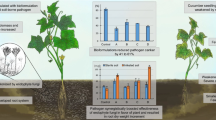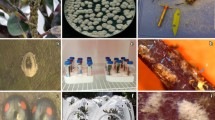Abstract
Even though the potential of the fungus Ampelomyces quisqualis against powdery mildew has been largely demonstrated, the efficacy of the commercialised product AQ10 Biofungicide is not consistent. Recently, a solid formulation of A. quisqualis strain CPA-9 that included biodegradable coatings on its composition was developed to overcome the major shortcomings of the biocontrol agents applied under practical conditions. The aims of the present study were to show the compatibility of CPA-9 with different phytosanitary products, and to confirm the potential of this novel formulation in different approaches: (i) under different conditions of temperature (20 and 30 °C) and relative humidity (40, 60 and 85%) on different surfaces (glass and zucchini leaves), (ii) after different rainfall episodes, and (iii) verifying Podosphaera xanthii parasitization by dried conidia of CPA-9. It was demonstrated that CPA-9 was compatible with several phytosanitary products, so it might be included in integrated management programmes. Moreover, the solid formulation showed better resilience than non-formulated conidia, both applied on a glass surface and on zucchini leaves. Adherence of both treatments on zucchini leaves did not show significant differences after simulated rainfall and all tested concentrations of dried conidia were able to produce pycnidia in P. xanthii hyphae. Therefore, the developed fluidised-bed spray-dried formulation of A. quisqualis CPA-9 together with coatings compounds has all the makings of becoming a biocontrol product, although their efficacy under practical conditions should be assessed.




Similar content being viewed by others
References
Aloui, H., Licciardello, F., Khwaldia, K., Hamdi, M., & Restuccia, C. (2015). Physical properties and antifungal activity of bioactive films containing Wickerhamomyces anomalus killer yeast and their application for preservation of oranges and control of postharvest green mold caused by Penicillium digitatum. International Journal of Food Microbiology, 200, 22–30. https://doi.org/10.1016/j.ijfoodmicro.2015.01.015.
Angeli, D. (2013). New insights into host specialization and mycoparasitic interaction between powdery mildew fungi and Ampelomyces quisqualis. Swiss Federal Institute of Technology, Zurich. https://doi.org/10.3929/ethz-a-009939831.
Angeli, D., Puopolo, G., Maurhofer, M., Gessler, C., & Pertot, I. (2012). Is the mycoparasitic activity of Ampelomyces quisqualis biocontrol strains related to phylogeny and hydrolytic enzyme production? Biological Control, 63, 348–358. https://doi.org/10.1016/j.biocontrol.2012.08.010.
Angeli, D., Saharan, K., Segarra, G., Sicher, C., & Pertot, I. (2017). Production of Ampelomyces quisqualis conidia in submerged fermentation and improvements in the formulation for increased shelf-life. Crop Protection, 97, 135–144. https://doi.org/10.1016/j.cropro.2016.11.012.
Brand, M., Messika, Y., Elad, Y., Rav, D., & Sztejnberg, A. (2009). Spray treatments combined with climate modification for the management of Leveillula taurica in sweet pepper. European Journal of Plant Pathology, 124, 309–329. https://doi.org/10.1007/s10658-008-9421-z.
Caffi, T., Legler, S. E., Bugiano, R., & Rossi, V. (2013). Combining sanitation and disease modelling for control of grapevine powdery mildew. European Journal of Plant Pathology, 135, 817–829. https://doi.org/10.1007/s10658-012-0124-0.
Calvo-Garrido, C., Elmer, P., Viñas, I., Usall, J., Bartra, E., & Teixidó, N. (2013). Biological control of botrytis bunch rot in organic wine grapes with the yeast antagonist Candida sake CPA-1. Plant Patholology, 62, 510–519. https://doi.org/10.1111/j.1365-3059.2012.02684.x.
Calvo-Garrido, C., Usall, J., Torres, R., & Teixidó, N. (2017). Effective control of Botrytis bunch rot in commercial vineyards by large-scale application of Candida sake CPA-1. BioControl, 62, 161–173. https://doi.org/10.1007/s10526-017-9789-9.
Calvo-Garrido, C., Viñas, I., Usall, J., Rodríguez-Romera, M., Ramos, M. C., & Teixidó, N. (2014). Survival of the biological control agent Candida sake CPA-1 on grapes under the influence of abiotic factors. Journal of Applied Microbiology, 117, 800–811. https://doi.org/10.1111/jam.12570.
Cañamás, T. P., Viñas, I., Torres, R., Usall, J., Solsona, C., & Teixidó, N. (2011). Field applications of improved formulations of Candida sake CPA-1 for control of Botrytis cinerea in grapes. Biological Control, 56, 150–158. https://doi.org/10.1016/j.biocontrol.2010.11.007.
Carbó, A., Torres, R., Usall, J., Ballesta, J., & Teixidó, N. (2020). Biocontrol potential of Ampelomyces quisqualis strain CPA-9 against powdery mildew: Conidia production in liquid medium and efficacy on zucchini leaves. Scientia Horticulturae, 267(1), 109337. https://doi.org/10.1016/j.scienta.2020.109337.
Carbó, A., Torres, R., Usall, J., Marín, A., Chiralt, A., & Teixidó, N. (2019). Novel film-forming formulations of the biocontrol agent Candida sake CPA-1: Biocontrol efficacy and performance at field conditions in organic wine grapes. Pest Management Science, 75(4), 959–968. https://doi.org/10.1002/ps.5200.
Carbó, A., Torres, R., Usall, J., Solsona, C., & Teixidó, N. (2017). Fluidised-bed spray-drying formulations of Candida sake CPA-1 by adding biodegradable coatings to enhance their survival under stress conditions. Applied Microbiology and Biotechnology, 101, 7865–7876. https://doi.org/10.1007/s00253-017-8529-5.
Droby, S., Wisniewski, M., Macarisin, D., & Wilson, C. (2009). Twenty years of postharvest biocontrol research: Is it time for a new paradigm? Postharvest Biology and Technology, 52, 137–145. https://doi.org/10.1016/j.postharvbio.2008.11.009.
Dukare, A. S., Paul, S., Nambi, V. E., Gupta, R. K., Singh, R., Sharma, K., & Vishwakarma, R. K. (2018). Exploitation of microbial antagonists for the control of postharvest diseases of fruits: A review. Critical Reviews in Food Science and Nutrition, 59(9), 1498–1513. https://doi.org/10.1080/10408398.2017.1417235.
Elad, Y., Kirshner, B., Yehuda, N., & Sztejnberg, A. (1998). Management of powdery mildew and gray mold of cucumber by Trichoderma harzianum T39 and Ampelomyces quisqualis AQ10. BioControl, 43, 241–251. https://doi.org/10.1023/A:1009919417481.
Fu, N., & Chen, X.D, (2011), Towards a maximal cell survival in convective thermal drying processes. Food Research International, 44, 1127–1149. https://doi.org/10.1016/j.foodres.2011.03.053.
Garriga, J., Ballesta, J., & Vilaplana, R. (2014). Composición para el control biológico del oídio en cultivos vegetales a base de una cepa de Ampelomyces. Patente ES 2 470 490 B2. ES 2 470 490 B2.
Gautam, A. K., & Avasthi, S. (2016). Ampelomyces quisqualis - a remarkable mycoparasite on Xanthium strumarium powdery mildew from Himachal Pradesh India. Journal of Phytopathology and Pest management, 3(2), 64–70.
Gilardi, G., Baudino, M., Garibaldi, A., & Gullino, M. L. (2012). Efficacy of biocontrol agents and natural compounds against powdery mildew of zucchini. Phytoparasitica, 40, 147–155. https://doi.org/10.1007/s12600-011-0206-0.
Gilardi, G., Gisi, U., Garibaldi, A., & Gullino, M. L. (2017). Effect of elevated atmospheric CO2 and temperature on the chemical and biological control of powdery mildew of zucchini and the Phoma leaf spot of leaf beet. European Journal of Plant Pathology, 148, 229–236. https://doi.org/10.1007/s10658-016-1078-4.
Gilardi, G., Manker, D. C., Garibaldi, A., & Gullino, M. L. (2008). Efficacy of the biocontrol agents Bacillus subtilis and Ampelomyces quisqualis applied in combination with fungicides against powdery mildew of zucchini. Journal of Plant Disease and Protection, 115, 208–213.
Gotor-Vila, A., Usall, J., Torres, R., Ramos, M. C., & Teixidó, N. (2017). Environmental stress responses of the Bacillus amyloliquefaciens CPA-8-formulated products on nectarines and peaches. Scientia Horticulturae, 225, 359–365. https://doi.org/10.1016/j.scienta.2017.07.015.
Greaves, M. P., Holloway, P. J., & Auld, B. A. (1998). Formulation of microbial herbicides. In H. D. Burges (Ed.), Formulation of Microbial Pesticides - Beneficial Microorganisms, Nematodes and Seed Treatments (pp 203–233). Kluwer Academic Publishers.
Ippolito, A., & Nigro, F. (2000). Impact of preharvest application of biological control agents on postharvest diseases of fresh fruits and vegetables. Crop Protection, 19, 715–723. https://doi.org/10.1016/S0261-2194(00)00095-8.
Kiss, L. (2003). A review of fungal antagonists of powdery mildews and their potential as biocontrol agents. Pest Management Science, 59, 475–483. https://doi.org/10.1002/ps.689.
Legler, S. E., Pintye, A., Caffi, T., Gulyás, S., Bohár, G., Rossi, V., & Kiss.L. (2016). Sporulation rate in culture and mycoparasitic activity, but not mycohost specificity, are the key factors for selecting Ampelomyces strains for biocontrol of grapevine powdery mildew (Erysiphe necator). European Journal of Plant Pathology, 144, 723–736. https://doi.org/10.1007/s10658-015-0834-1.
Marín, A., Cháfer, M., Atarés, L., Chiralt, A., Torres, R., Usall, J., & Teixidó, N. (2016). Effect of different coating-forming agents on the efficacy of the biocontrol agent Candida sake CPA-1 for control of Botrytis cinerea on grapes. Biological Control, 96, 108–119. https://doi.org/10.1016/j.biocontrol.2016.02.012.
Parafati, L., Vitale, A., Restuccia, C., & Cirvilleri, G. (2016). The effect of locust bean gum (LBG)-based edible coatings carrying biocontrol yeasts against Penicillium digitatum and Penicillium italicum causal agents of postharvest decay of mandarin fruit. Food Microbiology, 58, 87–94. https://doi.org/10.1016/j.fm.2016.03.014.
Pertot, I., Caffi, T., Rossi, V., Mugnai, L., Hoffmann, C., Grando, M. S., Gary, C., Lafond, D., Duso, C., Thiery, D., Mazzoni, V., & Anfora, G. (2017). A critical review of plant protection tools for reducing pesticide use on grapevine and new perspectives for the implementation of IPM in viticulture. Crop Protection, 97, 70–84. https://doi.org/10.1016/j.cropro.2016.11.025.
Ribeiro, C., Vicente, A. A., Teixeira, J. A., & Miranda, C. (2007). Optimization of edible coating composition to retard strawberry fruit senescence. Postharvest Biology and Technology, 44, 63–70. https://doi.org/10.1016/j.postharvbio.2006.11.015.
Rodríguez, M., Osés, J., Ziani, K., & Maté, J. I. (2006). Combined effect of plasticizers and surfactants on the physical properties of starch based edible films. Food Research International, 39, 840–846. https://doi.org/10.1016/j.foodres.2006.04.002.
Romero, D., De Vicente, A., Zeriouh, H., Cazorla, F. M., Fernández-Ortuño, D., Torés, J. A., & Pérez-García, A. (2007). Evaluation of biological control agents for managing cucurbit powdery mildew on greenhouse-grown melon. Plant Pathology, 56, 976–986. https://doi.org/10.1111/j.1365-3059.2007.01684.x.
Schweigkofler, W. (2006). Effects of fungicides on the germination of Ampelomyces quisqualis AQ10, a biological antagonist of the powdery mildew of the grapevine. Integrated Protection in Viticulture. IOBC/wprs Bull, 29, 79–82.
Sharma, R. R., Singh, D., & Singh, R. (2009). Biological control of postharvest diseases of fruits and vegetables by microbial antagonists: A review. Biological Control, 50, 205–221. https://doi.org/10.1016/j.biocontrol.2009.05.001.
Shishkoff, N., & McGrath, M. T. (2002). AQ10 biofungicide combined with chemical fungicides or AddQ spray adjuvant for control of cucurbit powdery mildew in detached leaf culture. Plant Disease, 86, 915–918. https://doi.org/10.1094/PDIS.2002.86.8.915.
Slininger, P. J., Behle, R. W., Jackson, M. A., & Schisler, D. A. (2003). Discovery and development of biological agents to control crop pests. Neotropical Entomology, 32, 183–195. https://doi.org/10.1590/S1519-566X2003000200001.
Spadaro, D., & Droby, S. (2016). Development of biocontrol products for postharvest diseases of fruit: The importance of elucidating the mechanisms of action of yeast antagonists. Trends in Food Science and Technology, 47, 39–49. https://doi.org/10.1016/j.tifs.2015.11.003.
Sucharzewska, E., Dynowska, M., Kubiak, D., Ejdys, E., & Biedunkiewicz, A. (2012). Ampelomyces hyperparasites - occurrence and effect on the development of ascomata of Erysiphales species under conditions of anthropopressure. Acta Societatis Botanicorum Poloniae, 81, 147–152. https://doi.org/10.5586/asbp.2012.023.
Sztejnberg, A. (1993). Ampelomyces quisqualis AQ10, CNCM I-807, for biological control of powdery mildew. US 5.190.754. 5.190.754.
Sztejnberg, A. (1991). Use of Ampelomyces quisqualis and a pure culture thereof. US 0 353 662 A3. 0 353 662 A3.
Usall, J., Torres, R., & Teixidó, N. (2016). Biological control of postharvest diseases on fruit: A suitable alternative? Current Opinion in Food Science, 11, 51–55. https://doi.org/10.1016/j.cofs.2016.09.002.
Acknowledgments
This research was supported by the INIA (Instituto Nacional de Investigación y Tecnología Agraria y Alimentaria) and FEDER (Fondo Europeo de Desarrollo Regional) through national project RTA2012-00067-C02-01. The research was also supported by the INIA and FSE (Fondo Social Europeo) for the PhD grant awarded to A. Carbó. The authors are also grateful to the CERCA Programme/Generalitat de Catalunya and the technical support provided by Celia Sánchez and Andrea Berge.
Author information
Authors and Affiliations
Corresponding author
Ethics declarations
Ethical statement
The research presented in this manuscript did not involve any animal or human participants.
Conflict of interests
The authors declare that they have no conflict of interests.
Rights and permissions
About this article
Cite this article
Carbó, A., Teixidó, N., Usall, J. et al. Formulated Ampelomyces quisqualis CPA-9 applied on zucchini leaves: influence of abiotic factors and powdery mildew mycoparasitization. Eur J Plant Pathol 161, 37–48 (2021). https://doi.org/10.1007/s10658-021-02302-y
Accepted:
Published:
Issue Date:
DOI: https://doi.org/10.1007/s10658-021-02302-y




